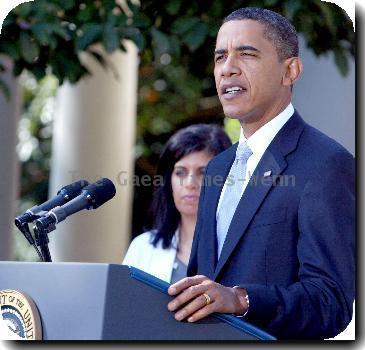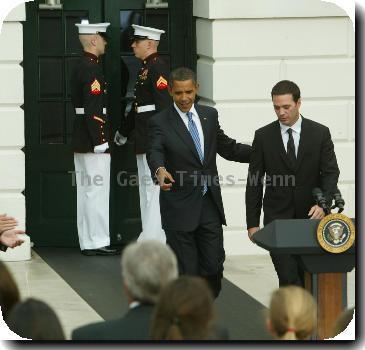Major oil spill was deemed ‘unlikely’ in BP environmental study for Gulf well that exploded
By Holbrook Mohr, APSaturday, May 1, 2010
BP plan deemed major spill from Gulf well unlikely
VENICE, La. — The worst U.S. oil spill in decades reached into precious shoreline habitat along the Gulf Coast as documents emerged showing British Petroleum downplayed the possibility of a catastrophic accident at the offshore rig that exploded.
The underwater spill remained unstopped and impossible to measure, raising fears that it could be pouring more oil into the Gulf than estimated.
President Barack Obama was planning to head to the Gulf Coast sometime in the next 48 hours to get an update on efforts to contain the massive spill, a senior administration official said Saturday on condition of anonymity because the trip has not been officially announced. Details of the trip were still being worked out.
BP suggested in a 2009 exploration plan and environmental impact analysis for the well that an accident leading to a giant crude oil spill — and serious damage to beaches, fish and mammals — was unlikely, or virtually impossible.
The Coast Guard estimates now that at least 1.6 million gallons of oil have spilled since the April 20 explosion that killed 11 workers. The environmental catastrophe could eclipse the Exxon Valdez disaster, when an oil tanker spilled 11 million gallons off Alaska’s shores in 1989.
“The sort of occurrence that we’ve seen on the Deepwater Horizon is clearly unprecedented,” BP spokesman David Nicholas told The Associated Press on Friday.
The plan for the Deepwater Horizon well, filed with the federal Minerals Management Service, said repeatedly that it was “unlikely that an accidental surface or subsurface oil spill would occur from the proposed activities.”
The company conceded a spill would impact beaches, wildlife refuges and wilderness areas, but argued that “due to the distance to shore (48 miles) and the response capabilities that would be implemented, no significant adverse impacts are expected.”
Robert Wiygul, an Ocean Springs, Miss.-based environmental lawyer and board member for the Gulf Restoration Network, said he doesn’t see anything in the document suggesting BP addressed the kind of technology needed to control such an enormous spill that far underwater.
“The point is, if you’re going to be drilling in 5,000 feet of water for oil, you should have the ability to control what you’re doing,” he said.
The spill — a slick more than 130 miles long and 70 miles wide — threatens hundreds of species of wildlife, including birds, dolphins, and the fish, shrimp, oysters and crabs that make the Gulf Coast one of the nation’s most abundant sources of seafood. Because of the risk of oil contamination, Louisiana closed some fishing grounds and oyster beds.
One expert said Friday that the volume of oil leaking from the well nearly 5,000 feet below the surface could actually be even higher, and that even more may escape if the drilling equipment continues to erode.
Ian R. MacDonald, an oceanography professor at Florida State University, said his examination of Coast Guard charts and satellite images indicated that 8 million to 9 million gallons had already spilled by April 28.
I hope I’m wrong. I hope there’s less oil out there than that. But that’s what I get when I apply the numbers,” he said.
Alabama’s governor said his state his preparing for a worst-case scenario of 150,000 barrels, or more than 6 million gallons per day.
“I hope they can cap this and we talk about ‘remember back when,’” Gov. Bob Riley said late Friday, “but we are taking that worst-case and building barriers against it.”
Coast Guard Admiral Mary Landry brushed off such fears, saying “I would caution you not to get fixated on an estimate of how much is out there.”
“This is highly imprecise, highly imprecise,” agreed Doug Suttles, BP’s chief operating officer for exploration and production. “We continue to respond to a much more significant case so that we’re prepared for that in the eventuality that the rate is higher.”
Although the cause of the explosion was under investigation, many of the more than two dozen lawsuits filed in the wake of the explosion claim it was caused when workers for oil services contractor Halliburton Inc. improperly capped the well — a process known as cementing. Halliburton denied it.
A sheen of oil from the edges of the slick was washing up at Venice, La., and other extreme southeastern portions of Louisiana. Animal rescue operations ramped up, including one at Fort Jackson, about 70 miles southeast of New Orleans. That rescue crew had its first patient, a bird covered in thick, black oil. The bird, a young northern gannet found offshore, is normally white with a yellow head.
Several miles out, the normally blue-green gulf waters were dotted with sticky, pea- to quarter-sized brown beads the consistency of tar. High seas were forecast through Sunday and could push oil deep into the inlets, ponds, creeks and lakes that line the boot of southeastern Louisiana. With the wind blowing from the south, the mess could reach the Mississippi, Alabama and Florida coasts by Monday.
Amid increased fingerpointing, efforts sputtered to hold back the spill, while the government desperately cast about for new ideas for dealing with the growing environmental crisis. President Barack Obama halted any new offshore drilling projects unless rigs have new safeguards to prevent another disaster.
Jane Lubchenco, head of the National Oceanic and Atmospheric Administration, met with fishermen and others Friday night in Venice and said she had participated in a conference call earlier with governors from the Gulf states and BP. Stemming the flow of oil is the top priority, she said.
“There is very deep concern about what is happening,” she told the group.
However, the seas were too rough and the winds too strong to burn off the oil, suck it up effectively with skimmer vessels, or hold it in check with the miles of orange and yellow inflatable booms strung along the coast.
The floating barriers broke loose in the choppy water, and waves sent oily water lapping over them.
“It just can’t take the wave action,” said Billy Nungesser, president of Louisiana’s Plaquemines Parish.
BP also sought ideas from some of its rivals and was using at least one of them Friday — applying chemicals underwater to break up the oil before it reaches the surface. That had never before been attempted at such depths.
Crews have struggled for days without success to activate the well’s underwater shut-off valve using remotely operated vehicles. They also are drilling a relief well in hopes of injecting mud and concrete to seal off the leak, but that could take three months.
As dawn broke Saturday over Venice, many of the oil-cleaning boats began another day tied to the docks. A few fishermen loaded gear and prepared to head to the marshes to try their luck one last time before the water becomes too oily to fish.
“I feel sorry for the local people down here,” said sport fisherman Ted Boddie, 67, of Shreveport, as he prepared to head out with his two sons and a few friends. “Sad deal. If all that stuff reaches shore, there’s going to be a lot of people out of work.”
A few boats made their way out in St. Bernard parish in eastern Louisiana, loaded with boom that would be wrapped around the coastal marshlands there. Back in Venice, local officials were meeting in hopes of activating a plan to allow shrimpers and other locals to lay booms, but the weather is a factor in those plans, too.
“It’s just the weather holding them up right now,” said Coast Guard spokesman Cory Mendenhall. “They’re looking at six- to nine-foot seas. Once they can, they’ll resume.”
Associated Press writers Melissa Nelson, Michael Kunzelman, Chris Kahn, Allen G. Breed, Vicki Smith, Janet McConnaughey, Alan Sayre, Tamara Lush and Brian Skoloff contributed to this report.
Eds: CORRECTS professor’s middle initial. UPDATES with more color, quote about weather stalling cleanup. Multimedia: An interactive on the oil rig accident and subsequent environmental threat is available, —national/oil_rig_accidents. Moving on general news and financial services. AP Video.
Tags: Accidents, Animals, Barack Obama, Birds, Coastlines And Beaches, Energy, Environmental Concerns, Explosions, Gulf, Louisiana, Marine Animals, Mouth Of The Mississippi River, North America, Oceans, Rivers And Streams, Search And Rescue Efforts, United States, Venice, Wildlife









